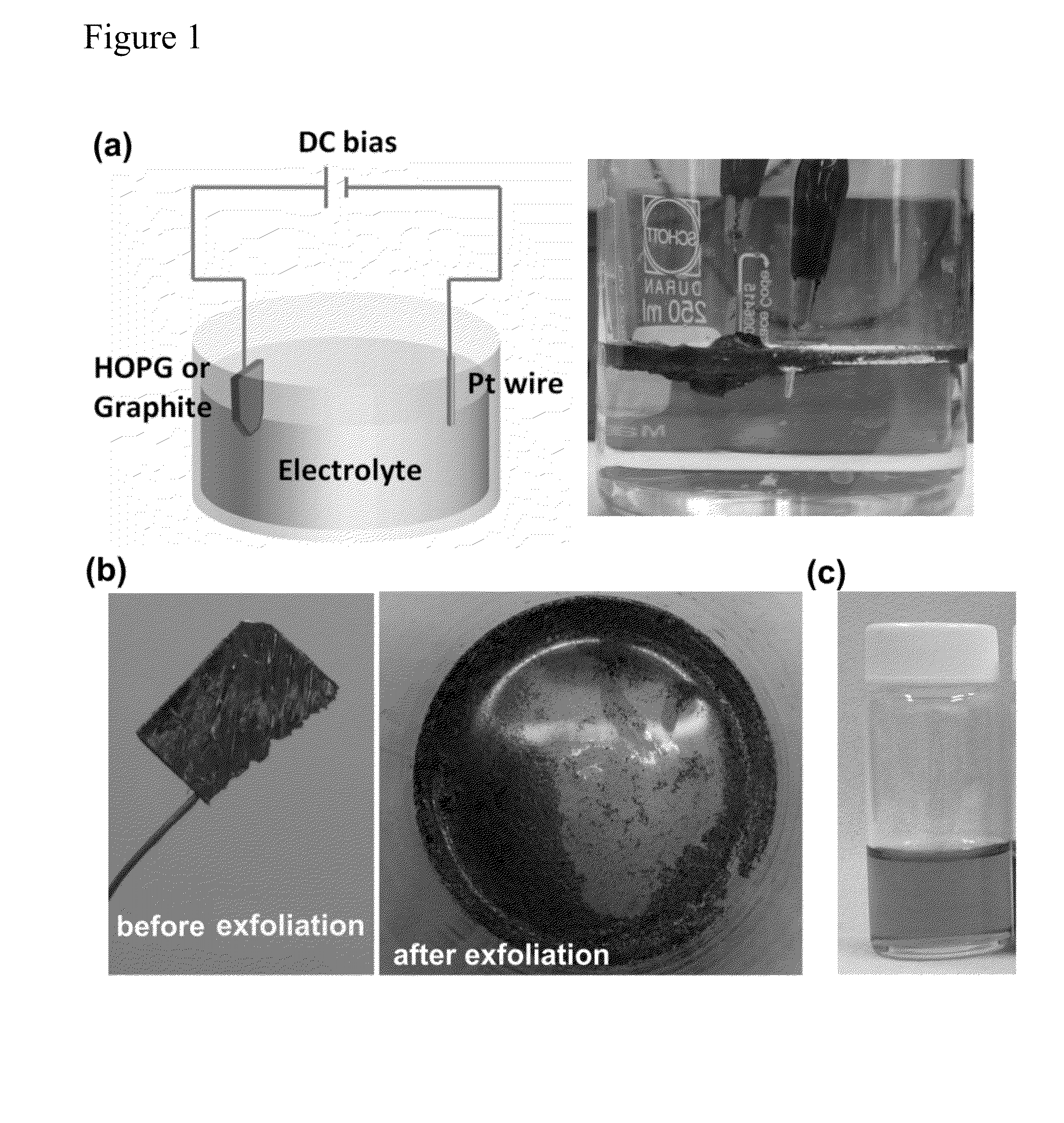Preparation of graphene sheets
a graphene film and graphene film technology, applied in the field of graphene film preparation, can solve the problems of low electric conductivity, inconvenient large-scale production, high cost, etc., and achieve the effect of improving the conductivity of the graphene film, and being easy to scale up
- Summary
- Abstract
- Description
- Claims
- Application Information
AI Technical Summary
Benefits of technology
Problems solved by technology
Method used
Image
Examples
example 1
Electrochemical Exfoliation of Graphene Sheets in a H2SO4-Containing Solution Having a Carbon Bulk Material as a First Electrode and a Pt Wire as a Second Electrode
[0039]A carbon bulk material, such as NGF (average dimensions of ˜5-20 mm×5-20 mm×0.3-0.6 mm) and HOPG (1.5 cm×1.5 cm×0.3 mm), was employed as an electrode and a source of graphene sheets for electrochemical exfoliation. The carbon bulk material was attached to a tungsten wire by a silver pad and then was inserted as an anode into a solution containing H2SO4 as an electrolyte. Note that only the carbon bulk material was immersed into the acid solution. A Pt wire was placed parallel to the carbon bulk material with a separation of 5 cm. The acid solution was prepared by dissolving 4.8 g of H2SO4 (Sigma-Aldrich; 98%) in 100 mL of deionized water. The electrochemical exfoliation process was carried out by applying a voltage bias of +1 V to the electrodes for 30 min, followed by a voltage bias of +5 or +10 V for 1 min or a vo...
example 2
Electrochemical Exfoliation of Graphene Sheets in a H2SO4-Containing Solution Having Carbon Bulk Materials as a First Electrode and a Second Electrode
[0042]Both electrodes employed carbon bulk materials, such as artificial graphite (2.0 cm×2.0 cm×3 mm) and HOPG (1.5 cm×1.5 cm×0.3 mm), as sources of graphene sheets for electrochemical exfoliation. The carbon bulk materials were each attached to a tungsten wire by a silver pad and then were inserted as an anode and a cathode into a solution containing H2SO4 as an electrolyte. As noted above, only the carbon bulk materials immersed into the acid solution. The acid solution was prepared by dissolving 4.8 g of H2SO4 in 100 mL of deionized water. The electrochemical exfoliation process was carried out by applying a voltage bias of +1 V to the electrodes for 30 min, followed by a voltage bias of +10 V for 1 min.
[0043]The electrochemical exfoliated graphene sheets can be collected and purified as described in Example 1 above.
[0044]This proc...
example 3
Electrochemical Exfoliation of Graphene Sheets in a H2SO4-Containing Solution Having a Nano-Carbon Material as a First Electrode and a Pt Wire as a Second Electrode
[0045]A nano-carbon material, such as a carbon material (2.0 cm×2.0 cm×3 mm) containing nanotubes each of 0.7-100 nm×2 nm-200 μm×0.8-1.6 nm, was employed as an electrode and a source of graphene sheets for electrochemical exfoliation. The nano-carbon material was attached to a tungsten wire by a silver pad and then was inserted as an anode into a solution containing H2SO4 as an electrolyte. Only the nano-carbon material was immersed into the acid solution. A Pt wire was placed parallel to the nano-carbon material with a separation of 5 cm. The acid solution was prepared by dissolving 4.8 g of H2SO4 in 100 mL of deionized water. The electrochemical exfoliation process was carried out by applying a voltage bias of +1 V to the electrodes for 30 min, followed by a voltage bias of +10 V for 1 min.
[0046]The electrochemical exfo...
PUM
| Property | Measurement | Unit |
|---|---|---|
| voltage | aaaaa | aaaaa |
| voltage | aaaaa | aaaaa |
| voltage | aaaaa | aaaaa |
Abstract
Description
Claims
Application Information
 Login to View More
Login to View More - R&D
- Intellectual Property
- Life Sciences
- Materials
- Tech Scout
- Unparalleled Data Quality
- Higher Quality Content
- 60% Fewer Hallucinations
Browse by: Latest US Patents, China's latest patents, Technical Efficacy Thesaurus, Application Domain, Technology Topic, Popular Technical Reports.
© 2025 PatSnap. All rights reserved.Legal|Privacy policy|Modern Slavery Act Transparency Statement|Sitemap|About US| Contact US: help@patsnap.com



